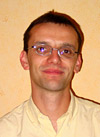EGU Outstanding Young Scientist Awardee 2005
|
|
Hugues Goosse for his work on polar oceans and their role in shaping the climate variability on interannual to centennial time scales. |
Hugues Goosse can be considered as one of these young researchers who have started to take the leadership in Earth system modelling and, in particular, in the understanding of the past climate variability at decadal-to-centennial time-scales. He is indeed well integrated in international research programmes, and his scientific contribution is very original and highly appreciated.
Hugues Goosse is presently Research Associate at the Belgian National Fund for Scientific Research and Invited Professor at the Université Catholique de Louvain (UCL, Louvain-la-Neuve) and the Gent Universiteit. He carried out his PhD research work at the Institut d'Astronomie et de Géophysique Georges Lemaître, UCL. He was one of the best PhD students we have seen. The goal of his thesis, which was of exceptional quality, was to investigate the interactions between the World Ocean thermohaline circulation and the Arctic and Antarctic sea-ice covers in order to improve our understanding of the natural variability of the climate system. The global three-dimensional model of the ocean–sea-ice system (CLIO) he developed was the first to show clearly that the production of deep water in the North Atlantic is mainly due to an intense cooling at the atmosphere–ocean interface and that the heat and mass exchanges between sea ice and ocean are the dominant processes for bottom-water formation in the Southern Ocean.
The next step was to quantify the possible feedbacks between the sea ice, the oceanic circulation, and the atmosphere at the global scale. To do so, Hugues Goosse coupled CLIO to the quasi-geostrophic atmospheric model ECBILT built at the KNMI (Koninklijk Nederlands Meteorologish Instituut, De Bilt) during a postdoctoral leave in the Netherlands. Because of its coarse resolution and the simplifications made to its atmospheric component, it is possible to perform with this coupled model much longer duration and a much larger number of sensitivity experiments than usually done with climate general circulation models. This helps to identify the role and potential importance of specific physical processes for the present climate and for climate changes.
The coupled model ECBILT–CLIO allowed Hugues Goosse to determine the mechanisms driving the decadal variability of the Arctic sea-ice volume, underlining the major influence of the exchanges between ocean and atmosphere in the North Atlantic area. Such a detailed study, which has never been conducted before, was particularly well received in the scientific community, being at the origin of invited talks at general assemblies of some of the most prestigious scientific associations like IAPSO (International Association of the Physical Sciences of the Ocean), EGS (European Geophysical Society), and AGU (American Geophysical Union). It is rewarding that recent results from high-resolution oceanic models confirm the conclusions derived from ECBILT–CLIO.
ECBILT–CLIO is now freely available on the Internet and is used by more than 10 groups around the world. This shows that, in addition to his own scientific production, Hugues Goosse has significantly and unselfishly contributed to the development of efficient tools that are used by other scientists to produce high-quality studies.
Very recently, Hugues Goosse used ECBILT–CLIO to study both the natural climate variability, which is internally generated by the non-linearity of the system, and the variability due to external forcings, such as variations in solar irradiance. In particular, he analysed the interactions between those two types of variability and evaluated the relative contribution of the various processes involved during the last 1000 years. It is worth mentioning that it was the first time that this kind of assessment was performed over such a time interval with a comprehensive coupled climate model.
At the date of 1st June 2004, Hugues Goosse is author or co-author of 34 papers published in international refereed journals that are frequently cited in the scientific literature. Furthermore, 5 papers are in press and 7 are submitted, leading to a total of 46 papers among which he is first author of 18. Those papers are published in the best journals. For instance, 3 of his 2004 papers are published or are in press in Climate Dynamics, 2 in Journal of Climate, 2 in Geophysical Research letters, 2 in Journal of Geophysical Research, and 1 in Paleoceanography. Those publications cover a wide spectrum of the geophysics (basic ocean dynamics, interactions between ocean and sea ice, climate variability in polar regions, paleoclimatology, influence of ocean currents on the Earth's rotation or on controlling biogeochemical cycles, …), giving a demonstration of his dynamism and also of his aptitude to deal with complex problems.
Hugues Goosse has given more than 40 oral presentations and is regularly invited to talk at international meetings. He is appointed as a reviewer by various journals and funding agencies and is currently invited to participate as expert to ACSYS/CliC and CLIVAR workshops. In particular, he has been very productive at EGS/EGU general assemblies. At the last three assemblies, he was first author of a total of 10 communications and co-author of 18 additional communications. At each of those assemblies, he was first author of a solicited talk. In addition, he was co-author of 2 other solicited talks in 2004. His presentations and posters were very much appreciated for their interest and clarity, showing that he is able to combine quantity and quality.
Hugues Goosse possesses those qualities that make him an international scientist of the highest rank. Both the analysis of scientific problems and model developments he has made or contributed to demonstrate his capability to sustain a leading role in long-term research on the Earth system. This is why we warmly recommend him for the Outstanding Young Scientist Award of the EGU.

